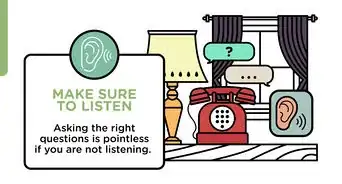X
wikiHow is a “wiki,” similar to Wikipedia, which means that many of our articles are co-written by multiple authors. To create this article, 26 people, some anonymous, worked to edit and improve it over time.
This article has been viewed 137,933 times.
Learn more...
The successful interrogation of a suspect is mostly about psychology and quick thinking. You shouldn't try to interrogate anyone if you lose your nerve or have a prejudice as to the innocence of the person. Be calm and try to find the truth, not to prove you're right in your suspicions. Be suspicious yourself so that the suspect is mystified.
Steps
-
1Start the interview with light conversation. While doing so, establish the character of the questioned person. This may involve their occupation, musical preferences, family, etc. During this preliminary chat look for signs if the person is nervous and scared, prone to bragging, confident or not. Mark their level of intelligence and adapt to it.[1]
-
2Switch to the subject of the questioning abruptly. This way you'll be able to notice the interviewed person's reaction. Remember that in 9 out of 10 cases the first impressions are the most correct.Advertisement
-
3Let the interrogated person tell you their story without interrupting them. Look for inconsistencies. Being too detailed often shows the person has been prepared for questioning and has had the time to make their story up.[2]
-
4Have another person enter the room shortly after the interviewed person has finished their story. Your associate must pretend to say something in your ear. Give the interviewed person a short look and excuse yourself.
-
5Return in about 20 minutes. At this time the suspect should be worried as to what has happened during your leave.
-
6Take about 5 minutes during which you may rearrange things on your desk, or scribble something on a scrap of paper. Then proceed to ask the suspect about the inconsistent points in his story.
-
7Ask for details. Some questions, like the color of a hit-and-run vehicle are easy to answer and the suspect saying they don't remember is an obvious attempt to conceal something. On the other hand, it would be strange for the interrogated person to have seen or remember the license number, so answering this question would show them having thought the whole thing over.[3]
-
8Combine the real questioning with irrelevant questions, leading the suspect into believing you have something on your mind.
-
9Look for signs the suspect is lying. These may include crossing the hands (defensive position), sitting on the edge of the chair, too relaxed posture, tilting their head to the right, looking up as they think of the answer.[4]
-
10Frequent use of expletives like "honestly", frankly, etc. shows that the suspect is lying. People who believe in what they say do not appeal to the listener's trust.[5]
-
11Ask the suspect a question the answer to which you already know. This way you can see whether they're willing to answer your questions correctly.
-
12Be careful about the details. For example, if the hit-and-run has been driving on the suspect's side of the road(assuming you're in a right-side traffic country), it's strange for the suspect to say the car had a scratch on the left side. How have they seen it? These little details most often reveal a liar.
-
13Remember that everyone lies when questioned. It does not mean they're a criminal.
Advertisement
Community Q&A
-
QuestionHow do I get a confession out of an employee who stole computer ram with company information on it?
 Community AnswerMake the employee your friend, and then, after a while, ask him/her for assistance on a certain topic which you know is contained in the data of the computer in which it was stolen.
Community AnswerMake the employee your friend, and then, after a while, ask him/her for assistance on a certain topic which you know is contained in the data of the computer in which it was stolen. -
QuestionWhat are some common questions used by an interrogator?
 Community Answer"Where were you on [date of the incident]?" "Can anyone verify your whereabouts on that date?" "What is your relationship to the victim?" If you're trying to figure out what happened, you need to ask Who, What, When, and Where questions. You want to find out exactly what happened, when and where it happened, and who was involved.
Community Answer"Where were you on [date of the incident]?" "Can anyone verify your whereabouts on that date?" "What is your relationship to the victim?" If you're trying to figure out what happened, you need to ask Who, What, When, and Where questions. You want to find out exactly what happened, when and where it happened, and who was involved. -
QuestionHow do I find out who stole from me at school?
 Dino LinCommunity AnswerBecause there are so many people inside a school, unless the stolen item has a high-value (i.e. money, which you can report to an administrator), your school has security cameras, or you know who stole your stuff and the stolen item has something on it to prove that it is your property, some people know that they can get away with stealing something from someone in school and that there's nothing you can do about it.
Dino LinCommunity AnswerBecause there are so many people inside a school, unless the stolen item has a high-value (i.e. money, which you can report to an administrator), your school has security cameras, or you know who stole your stuff and the stolen item has something on it to prove that it is your property, some people know that they can get away with stealing something from someone in school and that there's nothing you can do about it.
Advertisement
References
- ↑ https://www.policeone.com/investigations/articles/223709006-How-to-elicit-information-from-a-suspect-during-an-interrogation/
- ↑ https://pressbooks.bccampus.ca/criminalinvestigation/chapter/chapter-9-interviewing-questioning-and-interrogation/
- ↑ https://pressbooks.bccampus.ca/criminalinvestigation/chapter/chapter-9-interviewing-questioning-and-interrogation/
- ↑ https://www.forensicscolleges.com/blog/resources/10-signs-someone-is-lying
- ↑ https://www.forbes.com/sites/cherylsnappconner/2018/02/10/how-to-spot-a-lie-in-5-seconds-and-why-it-matters-in-pr/#1f5db0105959
About This Article
Advertisement







































































